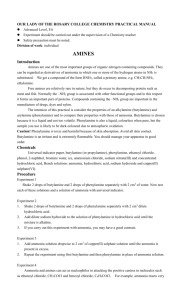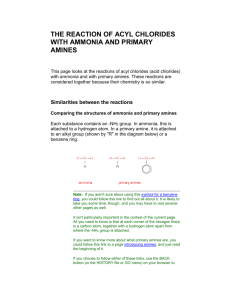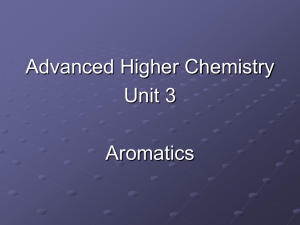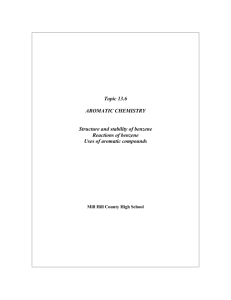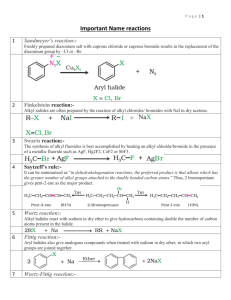INTRODUCING PHENYLAMINE
advertisement
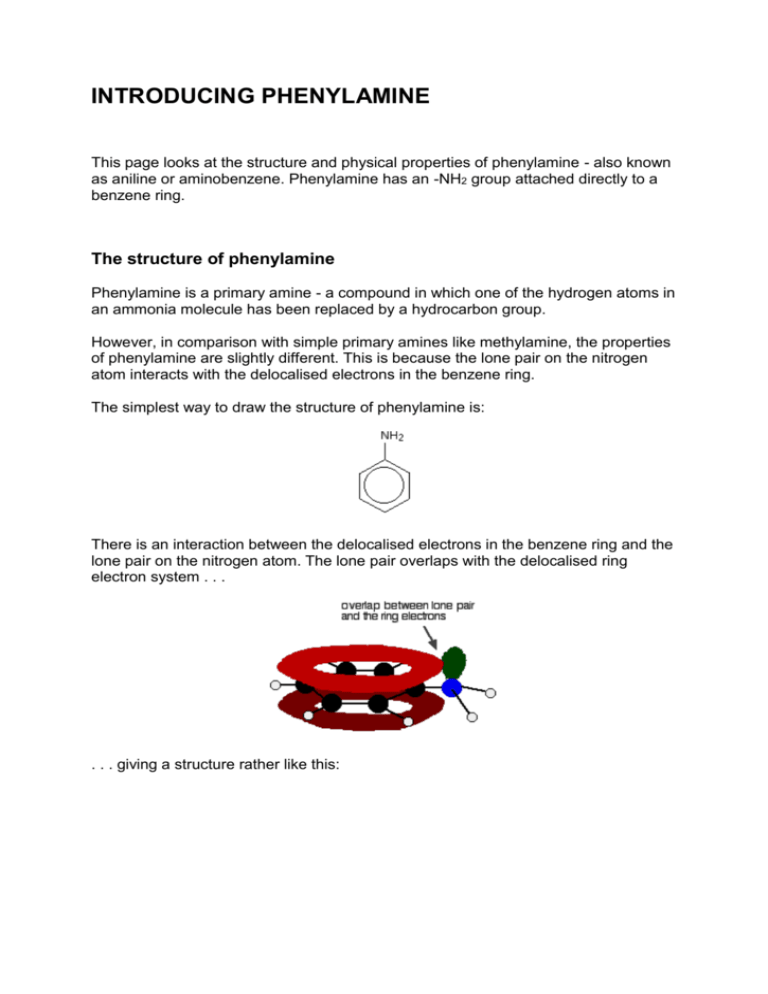
INTRODUCING PHENYLAMINE This page looks at the structure and physical properties of phenylamine - also known as aniline or aminobenzene. Phenylamine has an -NH2 group attached directly to a benzene ring. The structure of phenylamine Phenylamine is a primary amine - a compound in which one of the hydrogen atoms in an ammonia molecule has been replaced by a hydrocarbon group. However, in comparison with simple primary amines like methylamine, the properties of phenylamine are slightly different. This is because the lone pair on the nitrogen atom interacts with the delocalised electrons in the benzene ring. The simplest way to draw the structure of phenylamine is: There is an interaction between the delocalised electrons in the benzene ring and the lone pair on the nitrogen atom. The lone pair overlaps with the delocalised ring electron system . . . . . . giving a structure rather like this: The donation of the nitrogen's lone pair into the ring system increases the electron density around the ring. That makes the ring much more reactive than it is in benzene itself. It also reduces the availability of the lone pair on the nitrogen to take part in other reactions. In particular, it makes phenylamine much more weakly basic than primary amines where the -NH2 group isn't attached to a benzene ring. That will be explored elsewhere in this section. (See the phenylamine menu - link at the bottom of this page.) Physical properties Pure phenylamine is a colourless liquid, but it darkens rapidly on exposure to light and air. It is normally a brown oily liquid. Melting and boiling points It is useful to compare phenylamine's melting and boiling points with those of methylbenzene (toluene). Both molecules contain a similar number of electrons and are a very similar shape. That means that the intermolecular attractions due to van der Waals dispersion forces are going to be very similar. melting point (°C) boiling point (°C) C6H5NH2 -6.2 184 C6H5CH3 -95.0 111 The reason for the higher values for phenylamine is in part due to permanent dipoledipole attractions due to the electronegativity of the nitrogen - but is mainly due to hydrogen bonding. Hydrogen bonds can form between a lone pair on a nitrogen on one molecule and the hydrogen on the -NH2 group of one of its neighbours Solubility in water Phenylamine is slightly soluble in water - about 3.6 g (depending on where you get the data from!) of phenylamine will dissolve in 100 g of water at 20°C. Mixtures containing more phenylamine than this separate into two layers, with the phenylamine forming the bottom one. Phenylamine is somewhat soluble in water because of its ability to form hydrogen bonds with the water. However, the benzene rings in the phenylamine break more hydrogen bonds between water molecules than are reformed between water and the -NH2 groups. The water molecules also disrupt fairly strong van der Waals attractions between the phenylamine molecules. Both of these effects mean that dissolving phenylamine in water isn't very energetically profitable, and so stop the phenylamine from being very soluble. MAKING PHENYLAMINE This page looks in outline at the preparation of phenylamine (also known as aniline or aminobenzene) starting from benzene. The benzene is first converted to nitrobenzene which is in turn reduced to phenylamine. Benzene to nitrobenzene Benzene is nitrated by replacing one of the hydrogen atoms on the benzene ring by a nitro group, NO2. The benzene is treated with a mixture of concentrated nitric acid and concentrated sulphuric acid at a temperature not exceeding 50°C. The mixture is held at this temperature for about half an hour. Yellow oily nitrobenzene is formed. You could write this in a more condensed form as: The concentrated sulphuric acid is acting as a catalyst and so isn't written into the equations. The temperature is kept relatively low to prevent more than one nitro group being substituted onto the ring. Nitrobenzene to phenylamine The conversion is done in two main stages: Stage 1: conversion of nitrobenzene into phenylammonium ions Nitrobenzene is reduced to phenylammonium ions using a mixture of tin and concentrated hydrochloric acid. The mixture is heated under reflux in a boiling water bath for about half an hour. Under the acidic conditions, rather than getting phenylamine directly, you instead get phenylammonium ions formed. The lone pair on the nitrogen in the phenylamine picks up a hydrogen ion from the acid. The electron-half-equation for this reaction is: The nitrobenzene has been reduced by gaining electrons in the presence of the acid. The electrons come from the tin, which forms both tin(II) and tin(IV) ions. Stage 2: conversion of the phenylammonium ions into phenylamine All you need to do is to remove the hydrogen ion from the -NH3+ group. Sodium hydroxide solution is added to the product of the first stage of the reaction. The phenylamine is formed together with a complicated mixture of tin compounds from reactions between the sodium hydroxide solution and the complex tin ions formed during the first stage. The phenylamine is finally separated from this mixture. The separation is long, tedious and potentially dangerous - involving steam distillation, solvent extraction and a final distillation. Summary What you are likely to need for UK A level chemistry purposes can be summed up by: You are almost bound to need the mechanism for the nitration reaction as well. PHENYLAMINE AS A PRIMARY AMINE This page looks at reactions of phenylamine (also known as aniline or aminobenzene) where it behaves as a fairly straightforward primary amine. It explains why phenylamine is a weaker base than other primary amines, and summarises its reactions with acyl chlorides (acid chlorides), acid anhydrides and halogenoalkanes (haloalkanes or alkyl halides). Before you read each section on this page, you should follow the link to the corresponding page about aliphatic amines (those not based on benzene rings). In most cases, the reactions are the same, and this page only really looks in detail at the differences in the phenylamine case. Phenylamine as a base Amines are bases because the lone pair of electrons on the nitrogen atom can accept a hydrogen ion - in other words, for exactly the same reason that ammonia is a base. With phenylamine, the only difference is that it is a much weaker base than ammonia or an amine like ethylamine - for reasons that we will explore later. The reaction of phenylamine with acids Phenylamine reacts with acids like hydrochloric acid in exactly the same way as any other amine. Despite the fact that the phenylamine is only a very weak base, with a strong acid like hydrochloric acid the reaction is completely straightforward. Phenylamine is only very slightly soluble in water, but dissolves freely in dilute hydrochloric acid. A solution of a salt is formed - phenylammonium chloride. If you just want to show the formation of the salt, you could write: . . . or if you want to emphasise the fact that the phenylamine is acting as a base, you could most simply use: Getting the phenylamine back from its salt To get the phenylamine back from the phenylammonium ion present in the salt, all you have to do is to take the hydrogen ion away again. You can do that by adding any stronger base. Normally, you would choose sodium hydroxide solution. The phenylamine is formed first as an off-white emulsion - tiny droplets of phenylamine scattered throughout the water. This then settles out to give an oily bottom layer of phenylamine under the aqueous layer. The reaction of phenylamine with water This is where it is possible to tell that phenylamine is a much weaker base than ammonia and the aliphatic amines like methylamine and ethylamine. Phenylamine reacts reversibly with water to give phenylammonium ions and hydroxide ions. The position of equilibrium lies well to the left of the corresponding ammonia or aliphatic amine equilibria - which means that not many hydroxide ions are formed in the solution. The effect of this is that the pH of a solution of phenylamine will be quite a bit lower than a solution of ammonia or one of the aliphatic amines of the same concentration. For example, a 0.1 M phenylamine solution has a pH of about 9 compared to a pH of about 11 for 0.1 M ammonia solution. Why is phenylamine such a weak base? Amines are bases because they pick up hydrogen ions on the lone pair on the nitrogen atom. In phenylamine, the attractiveness of the lone pair is lessened because of the way it interacts with the ring electrons. The lone pair on the nitrogen touches the delocalised ring electrons . . . . . . and becomes delocalised with them: That means that the lone pair is no longer fully available to combine with hydrogen ions. The nitrogen is still the most electronegative atom in the molecule, and so the delocalised electrons will be attracted towards it, but the electron density around the nitrogen is nothing like it is in, say, an ammonia molecule. The other problem is that if the lone pair is used to join to a hydrogen ion, it is no longer available to contribute to the delocalisation. That means that the delocalisation would have to be disrupted if the phenylamine acts as a base. Delocalisation makes molecules more stable, and so disrupting the delocalisation costs energy and won't happen easily. Taken together - the lack of intense charge around the nitrogen, and the need to break some delocalisation - means that phenylamine is a very weak base indeed. The acylation of phenylamine The reactions with acyl chlorides and with acid anhydrides These are reactions in which the phenylamine acts as a nucleophile. There is no essential difference between these reactions and the same reactions involving any other primary amine. You will find a summary of the reactions below, but all the detailed explanations are on other pages. We'll take ethanoyl chloride as a typical acyl chloride, and ethanoic anhydride as a typical acid anhydride. The important product of the reaction of phenylamine with either of these is the same. Phenylamine reacts vigorously in the cold with ethanoyl chloride to give a mixture of solid products - ideally white, but usually stained brownish. A mixture of Nphenylethanamide (old name: acetanilide) and phenylammonium chloride is formed. The overall equation for the reaction is: With ethanoic anhydride, heat is needed. In this case, the products are a mixture of N-phenylethanamide and phenylammonium ethanoate. The main product molecule (the N-phenylethanamide) is often drawn looking like this: If you stop and think about it, this is obviously the same molecule as in the equation above, but it stresses the phenylamine part of it much more. Looking at it this way, notice that one of the hydrogens of the -NH2 group has been replaced by an acyl group - an alkyl group attached to a carbon-oxygen double bond. You can say that the phenylamine has been acylated or has undergone acylation. Because of the nature of this particular acyl group, it is also described as ethanoylation. The hydrogen is being replaced by an ethanoyl group, CH3CO-. The reaction of phenylamine with halogenoalkanes This is another reaction of phenylamine as a nucleophile, and again there is no essential difference between its reactions and those of aliphatic amines. Taking bromoethane as a typical halogenoalkane, the reaction with phenylamine happens in the same series of complicated steps as with any other amine. We'll just look at the first step. On heating, the bromoethane and phenylamine react to give a mixture of a salt of a secondary amine and some free secondary amine. In this case, you would first get Nethylphenylammonium bromide: . . . but this would instantly be followed by a reversible reaction in which some unreacted phenylamine would take a hydrogen ion from the salt to give some free secondary amine: N-ethylphenylamine. The reaction wouldn't stop there. You will get further reactions to produce a tertiary amine and its salt, and eventually a quaternary ammonium compound. If you want to explore this further, refer to the last link just up the page, and trace the sequence of equations through using phenylamine rather than ethylamine. MAKING DIAZONIUM SALTS FROM PHENYLAMINE This page looks at the reaction between phenylamine (also known as aniline and aminobenzene) and nitrous acid - particularly its reaction at temperatures of less than 5°C to produce diazonium salts. If you want to know about the reactions of the diazonium ions formed, you will find a link at the bottom of the page. The reactions of phenylamine with nitrous acid Nitrous acid (also known as nitric(III) acid) has the formula HNO2. It is sometimes written as HONO to show the way it is joined up. Nitrous acid decomposes very readily and is always made in situ. In the case of its reaction with phenylamine, the phenylamine is first dissolved in hydrochloric acid, and then a solution of sodium or potassium nitrite is added. The reaction between the hydrochloric acid and the nitrite ions produces the nitrous acid. You get the reaction: Because nitrous acid is a weak acid, the position of equilibrium lies well the right. Phenylamine reacts with nitrous acid differently depending on the temperature. The reaction on warming If the mixture is warmed, you get a black oily product which contains phenol (amongst other things), and nitrogen gas is given off. The reaction at low temperatures The solution of phenylamine in hydrochloric acid (phenylammonium chloride solution) is stood in a beaker of ice. The sodium or potassium nitrite solution is also cooled in the ice. The solution of the nitrite is then added very slowly to the phenylammonium chloride solution - so that the temperature never goes above 5°C. You end up with a solution containing benzenediazonium chloride: The positive ion, containing the -N2+ group, is known as a diazonium ion. The "azo" bit of the name refers to nitrogen. The ionic equation for the reaction is: Notice that the chloride ions from the acid aren't involved in this in any way. If you use hydrochloric acid, the solution will contain benzenediazonium chloride. If you used a different acid, you would just get a different salt - a sulphate or hydrogensulphate, for example, if you used sulphuric acid. The reactions of a diazonium salt are always done with a freshly prepared solution made in this way. The solutions don't keep. Diazonium salts are very unstable and tend to be explosive as solids. REACTIONS OF DIAZONIUM SALTS This page looks at some typical reactions of diazonium ions, including examples of both substitution reactions and coupling reactions. If you have come straight to this page from a search engine and want to know about the preparation of the diazonium ions, you will find a link at the bottom of the page. Substitution reactions of diazonium ions Diazonium ions are present in solutions such as benzenediazonium chloride solution. They contain an -N2+ group. In the case of benzenediazonium chloride, this is attached to a benzene ring. Benzenediazonium chloride looks like this: In this set of reactions of the diazonium ion, the -N2+ group is replaced by something else. The nitrogen is released as nitrogen gas. Substitution by an -OH group To get this reaction, all you need to do is warm the benzenediazonium chloride solution. The diazonium ion reacts with the water in the solution and phenol is formed - either in solution or as a black oily liquid (depending on how much is formed). Nitrogen gas is evolved. This is the same reaction that you get if you react phenylamine with nitrous acid in the warm. The diazonium ion is formed first and then immediately reacts with the water in the solution to give phenol. Substitution by an iodine atom This is a good example of the use of diazonium salts to substitute things into a benzene ring which are otherwise quite difficult to attach. (That's equally true of the previous reaction, by the way.) If you add potassium iodide solution to the benzenediazonium chloride solution in the cold, nitrogen gas is given off, and you get oily droplets of iodobenzene formed. There is a simple reaction between the diazonium ions and the iodide ions from the potassium iodide solution. Coupling reactions of diazonium ions In the substitution reactions above, the nitrogen in the diazonium ion is lost. In the rest of the reactions on this page, the nitrogen is retained and used to make a bridge between two benzene rings. The reaction with phenol Phenol is dissolved in sodium hydroxide solution to give a solution of sodium phenoxide. The solution is cooled in ice, and cold benzenediazonium chloride solution is added. There is a reaction between the diazonium ion and the phenoxide ion and a yelloworange solution or precipitate is formed. The product is one of the simplest of what are known as azo compounds, in which two benzene rings are linked by a nitrogen bridge. The reaction with naphthalen-2-ol Naphthalen-2-ol is also known as 2-naphthol or beta-naphthol. It contains an -OH group attached to a naphthalene molecule rather than to a simple benzene ring. Naphthalene has two benzene rings fused together. The reaction is done under exactly the same conditions as with phenol. The naphthalen-2-ol is dissolved in sodium hydroxide solution to produce an ion just like the phenol one. This solution is cooled and mixed with the benzenediazonium chloride solution. An intense orange-red precipitate is formed - another azo compound. The reaction with phenylamine (aniline) Some liquid phenylamine is added to a cold solution of benzenediazonium chloride, and the mixture is shaken vigorously. A yellow solid is produced. These strongly coloured azo compounds are frequently used as dyes known as azo dyes. The one made from phenylamine (aniline) is known as "aniline yellow" (amongst many other things - see note above). Azo compounds account for more than half of modern dyes. The use of an azo dye as an indicator - methyl orange Azo compounds contain a highly delocalised system of electrons which takes in both benzene rings and the two nitrogen atoms bridging the rings. The delocalisation can also extend to things attached to the benzene rings as well. If white light falls on one of these molecules, some wavelengths are absorbed by these delocalised electrons. The colour you see is the result of the non-absorbed wavelengths. The groups which contribute to the delocalisation (and so to the absorption of light) are known as a chromophore. Modifying the groups present in the molecule can have an effect on the light absorbed, and so on the colour you see. You can take advantage of this in indicators. Methyl orange is an azo dye which exists in two forms depending on the pH: As the hydrogen ion is lost or gained there is a shift in the exact nature of the delocalisation in the molecule, and that causes a shift in the wavelength of light absorbed. Obviously that means that you see a different colour. When you add acid to methyl orange, a hydrogen ion attaches to give the red form. Methyl orange is red in acidic solutions (in fact solutions of pH less than 3.1). If you add an alkali, hydrogen ions are removed and you get the yellow form. Methyl orange is yellow at pH's greater than 4.4. In between, at some point there will be equal amounts of the red and yellow forms and so methyl orange looks orange.
